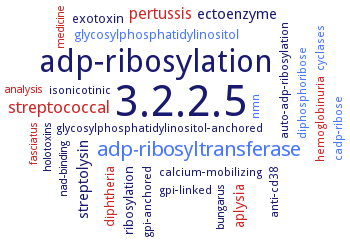3.2.2.5: NAD+ glycohydrolase
This is an abbreviated version!
For detailed information about NAD+ glycohydrolase, go to the full flat file.

Word Map on EC 3.2.2.5 
-
3.2.2.5
-
adp-ribosylation
-
adp-ribosyltransferase
-
streptococcal
-
pertussis
-
streptolysin
-
ectoenzyme
-
aplysia
-
diphtheria
-
ribosylation
-
exotoxin
-
glycosylphosphatidylinositol
-
isonicotinic
-
glycosylphosphatidylinositol-anchored
-
gpi-anchored
-
cadp-ribose
-
cyclases
-
hemoglobinuria
-
auto-adp-ribosylation
-
calcium-mobilizing
-
diphosphoribose
-
anti-cd38
-
gpi-linked
-
nmn
-
bungarus
-
medicine
-
fasciatus
-
nad-binding
-
analysis
-
holotoxins
- 3.2.2.5
-
adp-ribosylation
- adp-ribosyltransferase
- streptococcal
- pertussis
-
streptolysin
-
ectoenzyme
- aplysia
- diphtheria
-
ribosylation
-
exotoxin
- glycosylphosphatidylinositol
-
isonicotinic
-
glycosylphosphatidylinositol-anchored
-
gpi-anchored
- cadp-ribose
- cyclases
- hemoglobinuria
-
auto-adp-ribosylation
-
calcium-mobilizing
- diphosphoribose
-
anti-cd38
-
gpi-linked
- nmn
-
bungarus
- medicine
- fasciatus
-
nad-binding
- analysis
-
holotoxins
Reaction
Synonyms
(Streptococcus pyogenes NAD+ glycohydrolase), AA-NADase, Acute lymphoblastic leukemia cells antigen CD38, ADP-ribosyl cyclase/NAD+-glycohydrolase, ADPRC, ADRC, Antigen BP3, beta-NAD+ glycohydrolase, beta-NAD+glycohydrolase, BP-3 alloantigen, cADPr hydrolase, CagL, CD157, CD157 antigen, CD38, CD38 homolog, CD38 like activity, CD38H, co-toxin NADase, Cyclic ADP-ribose hydrolase, diphosphopyridine nucleosidase, diphosphopyridine nucleotidase, DPN hydrolase, DPNase, ecto-NAD-glycohydrolase, HvnA, HvnB, I-19, Lymphocyte differentiation antigen CD38, NACE, NAD glycohydrolase, NAD hydrolase, NAD nucleosidase, NAD(+) nucleosidase, NAD+ catabolizing enzyme, NAD+ glycohydrolase, NAD+-glycohydrolase, NAD+glycohydrolase, NAD-glycohydrolase, NADase, Nga, nicotinamide adenine dinucleotide glycohydrolase, nicotinamide adenine dinucleotide nucleosidase, NIM-R5 antigen, PA0093, PAAR motif containing protein, PFL_6209, pNADase, SmNACE, sNADase, SPN, T10, Tse6


 results (
results ( results (
results ( top
top





